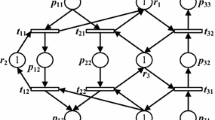Abstract
Petri nets have been proved to be a tool with prominent capabilities to describe discrete event systems, such as flexible manufacturing systems (FMS), thanks to their excellent properties over other models. Characterization in terms of special structural elements in a Petri net called siphons has been a major approach for the investigation of deadlock-freeness in context of FMS. Utilizing the optimal elementary siphons and the modified mixed integer programming (MIP) algorithm proposed in this paper, one can detect and solve deadlock problems arising in FMS in an iterative mode with tractable computational complexity. Moreover, the MIP approach can be exploited to implement the flexibility enhancement in the resultant net system so that the obtained system is less restricted. In contrast to the conventional typical policies, this approach evolves without explicitly enumerating all the strict minimal siphons. Its legitimacy and feasibility are proved and validated through an experimental study.
Similar content being viewed by others
References
Viswanadham N, Narahari Y, Johnson TL (1990) Deadlock prevention and deadlock avoidance in flexible manufacturing systems using Petri net models. IEEE Trans Robot Autom 6(6):713–723
Banaszak ZA, Krogh BH (1990) Deadlock avoidance in flexible manufacturing systems with concurrently competing process flows. IEEE Trans Robot Autom 6(6):724–734
Ezpeleta J, Colom JM, Martínez J (1995) A Petri net based deadlock prevention policy for flexible manufacturing systems. IEEE Trans Robot Autom 11(2):173–184
Park J, Reveliotis SA (2001) Deadlock avoidance in sequential resource allocation systems with multiple resource acquisitions and flexible routings. IEEE Trans Automat Contr 46(10):1572–1583
Fanti MP, Zhou MC (2004) Deadlock control methods in automated manufacturing systems. IEEE Trans Syst Man Cybern Part A 34(1):5–22
Wysk RA, Yang NS, Joshi S (1994) Resolution of deadlocks in flexible manufacturing systems: avoidance and recovery approaches. J Manuf Syst 13(2):128–136
Cho H, Kumaran TK, Wysk RA (1995) Graph-theoretic deadlock detection and resolution for flexible manufacturing systems. IEEE Trans Robot Autom 11(3):413–421
Lawley MA, Reveliotis SA, Ferreira PM (1997) Design guidelines for deadlock handling strategies in flexible manufacturing systems. Int J Flex Manuf Syst 9(7):5–30
Lawley MA, Reveliotis SA, Ferreira PM (1998) A correct and scalable deadlock avoidance policy for flexible manufacturing systems. IEEE Trans Robot Autom 14(5):796–809
Chu F, Xie XL (1997) Deadlock analysis of Petri nets using siphons and mathematical programming. IEEE Trans Robot Autom 13(6):793–804
Huang YS, Jeng MD, Xie XL, Chung SL (2001) Deadlock prevention policy based on Petri nets and siphons. Int J Prod Res 39(2):283–305
Jeng MD, DiCesare F (1995) Synthesis using resource control nets for modeling shared-resource system. IEEE Trans Robot Autom 11(3):317–327
Jeng MD, Xie XL (1999) Analysis of modularly composed nets by siphons. IEEE Trans Syst Man Cybern Part A 29(4):399–406
Jeng MD (1997) A Petri net synthesis theory for modeling flexible manufacturing systems. IEEE Trans Syst Man Cybern Part A 27(2):169–183
Jeng MD, Xie XL, Peng MY (2002) Process nets with resources for manufacturing modeling and their analysis. IEEE Trans Robot Autom 18(6):875–889
Li ZW, Zhou MC (2004) Elementary siphons of Petri net and their application to deadlock prevention for flexible manufacturing systems. IEEE Trans Syst Man Cybern Part A 34(1):38–51
Reveliotis SA, Lawley MA (1997) Polynomial complexity deadlock avoidance policies for sequential resource allocation systems. IEEE Trans Automat Contr 42(10):1344–1357
Reveliotis SA, Ferreira PM (1996) Deadlock avoidance policies for automated manufacturing cells. IEEE Trans Robot Autom 12(6):845–857
Li ZW, Hu HS, Zhou MC (2004) An algorithm for an optimal set of elementary siphons in Petri nets for deadlock control. In: Proceedings of the IEEE International Conference on Systems, Man, and Cybernetics, Hague, Netherlands, October 10–13, pp 4849–4854
Xing KY, Hu BS, Chen HX (1996) Deadlock avoidance policy for Petri net modeling of flexible manufacturing systems with shared resources. IEEE Trans Automat Contr 41(2):289–295
Uzam M (2002) An optimal deadlock prevention policy for flexible manufacturing systems using Petri net models with reosurces and the theory of regions. Int J Adv Manuf Technol 19(3):192–208
Uzam M, Wonham WM (2006) A hybrid approach to supervisory control of discrete event systems coupling RW supervisors to Petri nets. Int J Adv Manuf Technol 28(7–8):747–760
Uzam M, Wonham WM (2006) A hybrid approach to supervisory control of discrete event systems coupling RW supervisors to Petri nets. Int J Adv Manuf Technol 28(7–8):747–760
Uzam M (2004) The use of Petri net reduction approach for an optimal deadlock prevention policy for flexible manufacturing systems. Int J Adv Manuf Technol 23(3–4):204–219
Abdallah IB, ElMaraghy HA (1998) Deadlock prevention and avoidance in FMS: a Petri net based approach. Int J Adv Manuf Technol 14(10):704–715
Iordache MV, Antsaklis PJ (2003) Synthesis of supervisors enforcing general linear constraints in Petri nets. IEEE Trans Automat Contr 48(11):2036–2039
Yamalidou K, Moody JO, Lemmon MD, Antsaklis PJ (1996) Feedback control of Petri nets based on place invariants. Antomatica 32(1):15–28
Moody JO, Antsaklis PJ (2000) Petri net supervisors for DES with uncontrollable and unobservable transitions. IEEE Trans Automat Contr 45(3):462–476
Iordache MV, Antsaklis PJ (2003) Design of T-liveness enforcing supervisors in Petri nets. IEEE Trans Automat Contr 48(11):1962–1974
Iordache MV, Moody JO, Antsaklis PJ (2002) Synthesis of deadlock prevention supervisors using Petri nets. IEEE Trans Robot Autom 18(1):59–68
Ezpeleta J, Tricas F, García-vallés F, Colom JM (2002) A banker’s solution for deadlock avoidance in FMS with flexible routing and multiresources states. IEEE Trans Robot Autom 18(4):621–625
Murata T (1989) Petri nets: properties, analysis and application. Proc IEEE 77(4):541–580
Scharge L (2004) Optimization modeling with LINGO. Lindo Systems Inc., Chicago, IL
Author information
Authors and Affiliations
Corresponding author
Rights and permissions
About this article
Cite this article
Hu, H., Li, Z. An optimal-elementary-siphons-based iterative deadlock prevention policy for flexible manufacturing systems. Int J Adv Manuf Technol 38, 309–320 (2008). https://doi.org/10.1007/s00170-007-1110-0
Received:
Accepted:
Published:
Issue Date:
DOI: https://doi.org/10.1007/s00170-007-1110-0




